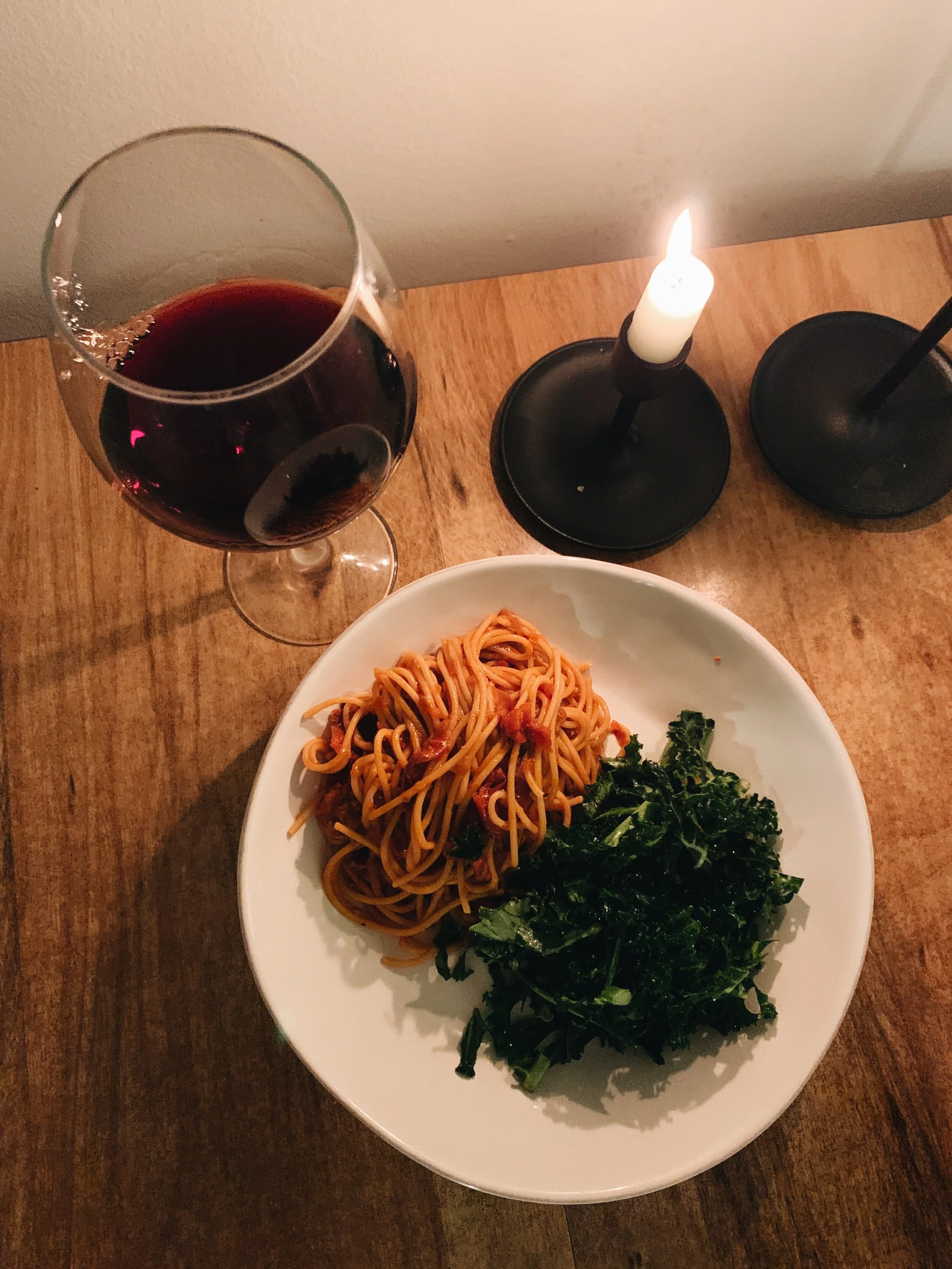My goodness, this tomato sauce made me swoon. It’s worth every hour it takes to make. This recipe is NOT Alison’s Shallot/Anchovy pasta which went absolutely viral in 2020. That pasta is really good, but I liked this one better. Mostly because I’m in love with tomatoes.** And this sauce still has that lovely umami flavor that only anchovies can bring. (No, you absolutely may not skip the anchovies. Don’t ask that.)
My cooking timeline.
2:40pm - I slice and arrange the tomatoes in their baking dishes with some smashed garlic cloves and fresh thyme. Into the oven they go.
3:26pm - I’m sitting on my living room floor and writing the Hard-Roasted Cauliflower entry. My thoughts are suddenly interrupted by the smell of roasted tomatoes. Heaven.
4:10pm - I turn on the oven light so I can spy on the tomatoes.
5:30pm - I sneakily spoon a few of the smaller tomatoes out of the baking dish and snack on them with some flaky sea salt. I’m pretty sure I could just eat all the tomatoes for my meal and feel totally satisfied.
5:48pm - Tomatoes will be ready soon, so I slice and sauté the red onion. I add the anchovies, watching them melt and disappear before plopping in some tomato paste.
5:59pm - I start bringing my pasta water to a boil.
6:05pm - I take the tomatoes out of the oven, the sizzling olive oil makes crackling sounds as the roasting pan sits on top of my stove. I spoon the tomatoes into the pot with the onions and stir. The smell is incredible.
6:10pm - I cook my pasta. I used yellow lentil & brown rice spaghetti noodles from TJ’s, and quite frankly, I couldn’t tell the difference between regular wheat pasta. (I’m GF by necessity, not by choice, believe me. So no bucatini, but something close enough.)
6:12pm - I watch the tomatoes slowly break down and the sauce thicken in the pot.
6:18pm - I add the cooked pasta to my sauce pot with some cooking water and swirl it all until the sauce sticks to the noodles. I plate the pasta with a simple kale salad with lemon. Dinnertime magic. J confirms that this is the only tomato sauce I should ever make in the future.
6:45pm - I do the dishes, and remember to reserve the leftover olive oil from the tomato dish. I’ll use it on a roast chicken for a dinner party with my in-laws tomorrow.
I eat the pasta leftovers for my lunch the next day and feel zero bitterness about eating leftovers for lunch.
8 recipes cooked, 217 recipes to go.
**Below are several anecdotal memories I have of tomatoes, because I’m trying to write about my experience with food as much as the recipes themselves.
My first memory of tomatoes is eating my mom’s spaghetti with “red sauce.” I grew up on a limited rotation of dependable dinners like ground beef tacos, chicken and broccoli casserole, and spaghetti. The best nights were always spaghetti nights, not because of the pasta, but because of the tangy jarred marinara sauce.
I’ve lived about 40% of my life in the Chicagoland area which is known for its deep dish pizza. And since you (didn’t) ask, I will declare that the best pizza in all of Chicago is from Lou Malnati’s for the sole reason that their pizzas are sauce-forward. Their sauce is made from a balanced blend of tomato chunks and pureed tomato, and it’s perfectly salty and infused with garlic. I always ask for an extra bowl of sauce to dip my pizza into, because it’s that good.
In 2019, my husband and I lived our best lives in Italy. We took a 3 week trip there to celebrate his grad school graduation. We hiked by the ocean, looked at countless pieces of art and architecture, and Vespa’ed through wine country. If I could really live anywhere, I’d pick the quiet hillside town of Assisi. Since most of our days were filled with nonstop carbo-loading (and cheap wine drinking), we figured we better eat at least one meal on the “healthier” side each day. So every few days, we’d find a local food market and buy butter, a carton of eggs, and a box of fresh cherry tomatoes to cook our own breakfast (before later going to a cafe to buy fresh croissants). I don’t know if it was the lack of pesticides, or the climate, or the novelty of being in Italy, or some combination, but those cherry tomatoes really were the most juicy and flavorful tomatoes I’ve ever had. No cherry tomatoes, even in California, have matched them since.
Me living my best life in Italy by the sea.























